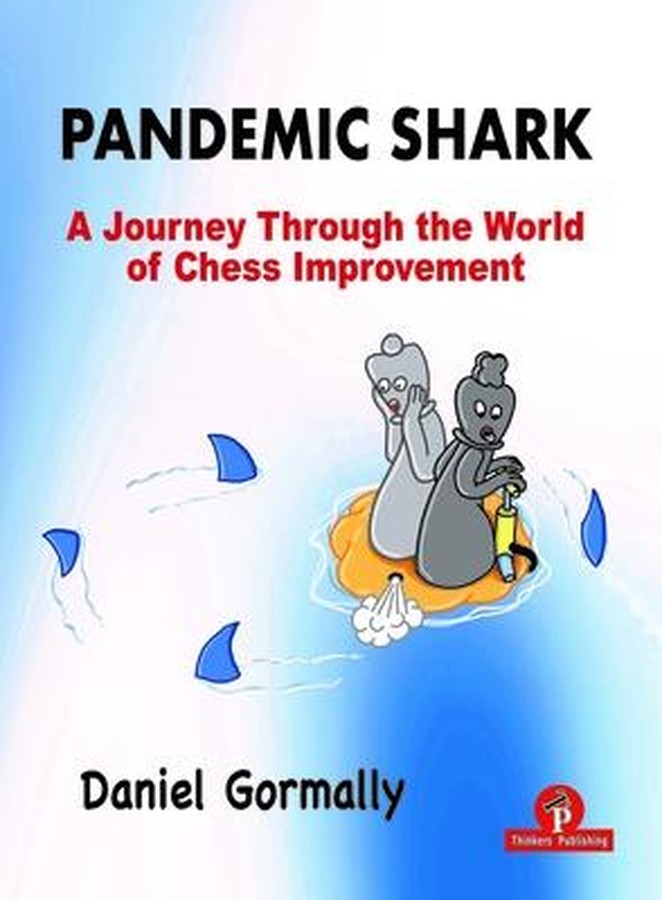| Utgivelsesdato | Juni 2022 |
| Forfatter | |
| Pris | 335 NOK |
Pandemic Shark
A Journey Through the World of Chess ImprovementLeseverdig og dels tankevekkende stoff fra stormester Gormally. Han tegner og forteller om sjakklivet i Pandemiens tid, og reflekterer over nivåforskjeller og hva ikke-mesterspillere trenger for å komme videre.
En høyst personlig og ganske original bok å kunne glede seg over.
Innholdsfortegnelsen:
009 Introduction
011 1. Lessons on Skype
019 2. From Sochi with Love
057 3. Scar Tissue
077 4. Transformation
101 5. Screw Books, Get Out and Play
119 6. To Hull and Back
141 7. Pandemic Shark
163 8. Weak GM vs Komodo
173 9. The North Sea Offence
185 10. Is It Worth Being a Chess Streamer?
197 11. Toughness
215 12. Nine Positions
Fra forfatterens innledning:
I was once dismissive of the attempts by amateur players to improve. To me it seemed too obvious - you either had it or you didn’t. Talent was ultimately all that mattered. All my writing on chess was really for myself. If amateur players couldn’t follow, tough.
I don’t think that this dismissive attitude towards amateurs by professional chess players is particularly unusual. There is plenty of talk about ‘fish’, and in professional circles a general level of contempt is always on display. Perhaps we too easily forget that we were once ‘fish’ and ‘patzers’ ourselves, and are probably still viewed as such by even higher-rated players. It is only recently that I have started to think more along the lines of how amateur players approach chess, and the typical mistakes they make.
Classic mistakes by amateur players include:
-
Moving a piece too often in the opening. This is one of the mainstays which I think relates at least partly to the desire to create something in the opening, when we would be better advised to focus on simple devel-opment.
-
Impatience. Sometimes amateur players are too eager to change some-thing when there really is no need.
-
Overgeneralising. One of the biggest differences I’ve noticed when com-paring professional play to amateur play is that the former is much more about concrete calculation - you go there, I go here and so on - whereas an amateur player will have a tendency to overgeneralise when thinking about a position, perhaps because they are not used to the basic art of calculation.
-
Cutting variations off too quickly. Amateur players do not extend their calculation far enough, and thus superficiality tends to kick in.
These and other mistakes I will try to explain in the book. Of course it should be noted that professional players also make these kinds of mistakes. I certainly do, all the time, so there is plenty of overlap and understanding of where these mistakes come from.
About the Author
Born 04/05/1976 Currently living in Alnwick, Northumberland, England. Daniel has been a chess professional for over twenty years, in which time he has played in many tournaments both in the U.K. and abroad. He has represented England in the European team championships and the Olympiad. Daniel has taken high placing in the British chess championships and on several occasions has placed in a tie for second. He is also the two times winner of the English rapid play championships. In 2005 he scored his final Grandmaster norm in a tournament in Gibraltar, where he scored a 2693 performance. In that tournament he played against several world-class grandmasters, including Nakamura, Aronian, Sutovsky and Dreev, and only lost one game. He is also the author of several well-received chess books, including a year in the chess world and mating the castled king, one of the few western chess books in recent years to be translated into Chinese. As a writer he is known for his laid-back and humorous style. This is second book for Thinkers, after the bestselling ' The Comfort Zone'' of 2021.
| Innbundet? | Nei |
| Type | Bok |
| Språk | Engelsk |
| Antall sider | 229 |

